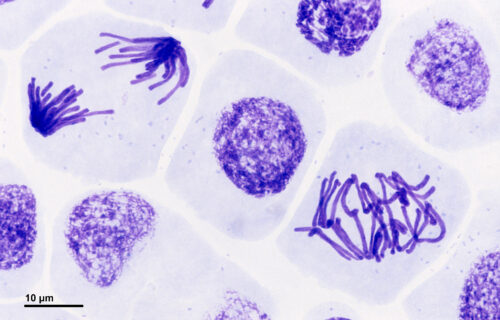A human being is composed of about 37.2 trillion cells, seven octillion atoms, sixty thousand miles of blood vessels, three billion DNA base pairs, and thirty thousand genes. Yet, despite this profound intricacy, a person originates from a single cell that splits via the mitotic process of the first cell division. After DNA replication and the separation of chromosomes, proteins called microfilaments form a cytokinetic ring, which divides the cytoplasm and generates two daughter cells. But before the first cell division, waves within the cellular fluid disseminate for proper formation of the ring. Such patterns of wave oscillations allow for the application of thermodynamic principles to measure the metabolic costs dictating the development of your very being.
In the Laboratory of Living Matter at Yale University, Michael P. Murrell, Benjamin B. Machta, and Daniel S. Seara introduced the entropy production factor (EPF) to quantify the irreversibility of biochemical oscillations, the propagation of signals in various biological processes, and the associated energetic expense. “The entropy production factor is a quantity that correctly measures irreversibility in order to give a total amount of energy consumed or, equivalently, how much entropy is being produced,” Seara said. The EPF builds upon the second law of thermodynamics, which states that the universe tends toward disorder and that entropy—the measure of energy unavailable for mechanical work—increases over time.
The second law lends itself to a discussion of irreversibility and time-reversal symmetry, which form the basis of Murrell, Machta, and Seara’s research. Irreversible processes increase the entropy of the universe and thus proceed only in the forward direction, as the reverse direction would contradict the second law. Furthermore, irreversible processes break time-reversal symmetry, such that the forward direction is distinguishable from the reverse direction and that time points unidirectionally. A recording of an explosion, for example, looks noticeably different when played in the forward versus the reverse direction. The researchers introduced the EPF to effectively measure the evolution of a system and its likelihood of returning to an initial state. “We are using a precise statistical measurement of, for example, how likely a particle is to move to the right or left at the next time point. By quantifying this, it intuitively gives you the irreversibility and also the shortcut to how much energy is being dissipated,” Seara said.
In full, the EPF quantifies the breakage of time-reversal symmetry that is characteristic of irreversible processes. Thus, the EPF provides a measure of how much entropy is produced, or how much energy is dissipated and unavailable for work. “The statistical measure of how hard it would be to distinguish if the movie is being played forward or backward is exactly how much energy is being wasted,” Machta said.
Applying this method, the team used their EPF to quantify phase transitions of the Brusselator, a model of biochemical oscillations. With the EPF, they not only measured irreversibility but also the energetic costs of the Brusselator’s spatiotemporal waves—waves with both space and time characteristics.
The EPF is a breakthrough in the field of nonequilibrium thermodynamics, as previous measures of entropy production only measured changes in single quantities without recognition of the spatial dimension. “This method is far more inclusive of the degrees of freedom and information in the system,” Murrell said. The EPF is particularly extraordinary in its applicability to biological systems and insight regarding the energetic costs of metabolic processes. “We are interested in applying this method to relate energetic principles to fundamental biological events,” Murrell said.
The Yale Laboratory of Living Matter is currently researching an organism’s first cell division by quantifying the energy dissipation of biochemical oscillations necessary to form a cytokinetic ring. “There are traveling waves of proteins for cell division that propagate across the surface of the cell and are implicated in properly locating the equator of the cell to divide in a healthy and robust way,” Seara said. By quantifying irreversibility, the EPF has the power to unearth the metabolic costs of an organism’s first cell division. Thus, it may provide insight into human development from a single zygote to an individual composed of about 37.2 trillion cells, seven octillion atoms, sixty thousand miles of blood vessels, three billion DNA base pairs, and thirty thousand genes.
Citations
Afework, B., Hanania, J., Stenhouse, K., & Donev, J. (2018, June 25). Entropy. Energy Education. Retrieved February 14, 2021, from https://energyeducation.ca/encyclopedia/Entropy
Bailey, B. (2014). Entropy and the second law of thermodynamics: Disorder and the unavailability of energy. In J. Rittenbach (Author), Concepts of physics with linear momentum and DC circuits. https://cnx.org/contents/UfumKqbv@12.12:jcBmTbgj@1/Entropy-and-the-Second-Law-of-Thermodynamics-Disorder-and-the-Unavailability-of-Energy
Clegg, B. (2013, January 23). 20 amazing facts about the human body. The Guardian. Retrieved February 14, 2021, from https://www.theguardian.com/science/2013/jan/27/20-human-body-facts-science
Eveleth, R. (2013, October 23). There are 37.2 trillion cells in your body. Smithsonian Magazine. Retrieved February 14, 2021, from https://www.smithsonianmag.com/smart-news/there-are-372-trillion-cells-in-your-body-4941473/
Seara, D. S., Machta, B. B., & Murrell, M. P. (2021). Irreversibility in dynamical phases and transitions. Nature Communications, 12(1), 392. https://doi.org/10.1038/s41467-020-20281-2
Spakovszky, Z. S. (n.d.). Some overall comments on entropy, reversible and irreversible processes. Thermodynamics and Propulsion. Retrieved February 14, 2021, from https://web.mit.edu/16.unified/www/FALL/thermodynamics/notes/node51.html

